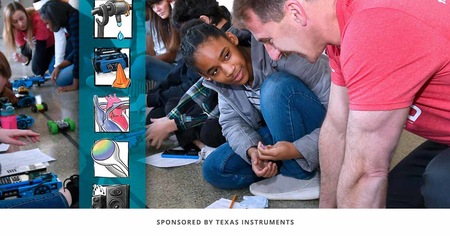High-quality STEM opportunities help youth develop critical-thinking, collaboration and problem-solving skills; enhance creativity; and engage in an investigative process. These skills are key for future job security, as STEM-related jobs are some of the fastest growing jobs in the country and 80 percent of all future jobs will require STEM literacy and skills. STEM skills are also critical for all members of our society to be informed consumers and make decisions about complex issues that face the world.
Before we discuss finding STEM learning opportunities, let's briefly touch on three topics: U.S. STEM Growth, the importance of out-of-school STEM programs and family involvement.
U.S. STEM GROWTH
STEM education brings prosperity, preparedness and opportunity. Exposure to formal and informal learning in STEM subjects prepares students for the future. Supporting quality STEM education for all youth is, therefore, vital to the nation's social and economic prosperity.
- One job in the high-tech sector leads to 4.3 jobs in local goods and services industries—which results in positive ripple effects across the entire economy.1 Between 2014 and 2024, the number of STEM jobs will grow 17 percent, as compared to 12 percent for non-STEM jobs.
- At all levels of educational attainment, STEM job holders earn 11 percent higher wages compared to their same-degree counterparts in other jobs.2
- Almost all of the 30 fastest-growing occupations in the next decade will require at least some background in STEM.3
OUT-OF-SCHOOL STEM PROGRAMS
Afterschool and summer learning programs around the nation have enthusiastically embraced STEM programming and are engaging youth in STEM learning. A recent study showed that 7 million children are participating in afterschool STEM programs in the U.S.4
A study of the U.S. Department of Education's 21st Century Community Learning Centers program showed that participating students had fewer absences and less tardiness, higher grades, higher rates of homework completion and increased rates of parental involvement in school. 5
The National Research Council's Board on Science Education concluded in a recent 2015 study that out-of-school programs have been shown to:
- Contribute to young people's interest in and understanding of STEM.
- Connect young people to caring adults who serve as role models.
- Reduce the achievement gap between young people from low-income and high-income families.6
FAMILY INVOLVEMENT
The benefits of family involvement in a child's education are well established. Research has consistently found that parental involvement improves student achievement, motivation and attitudes about school regardless of socioeconomic status, ethnicity or educational background.
Yet supporting STEM education and activities can be a challenge for families. Many do not understand the importance of STEM in general, as the underpinning of a successful future. Others are intimidated by their own lack of expertise. Providing opportunities for positive experiences can also stimulate enthusiasm and curiosity in parents, particularly when they actively participate alongside their children.
Additionally, for working parents, out-of-school programs keep kids safe and supported:
- A study of working parents found that parents miss an average of five days of work per year due to a lack of afterschool care. Decreased worker productivity related to parental concerns about afterschool care costs businesses up to $300 billion per year.7
- Three out of four parents agree that afterschool programs give them peace of mind about their children when they are at work.8
Finding STEM Learning Opportunities
Understanding that U.S. STEM growth is vital and that out-of-school programs and family involvement are key to a child's success rate we can now look at how to find STEM learning opportunities.
As the largest database of STEM opportunities in the U.S., The Connectory makes it easy for families to discover local STEM opportunities for the children in their lives.
By visiting The Connectory, parents and other caregivers can find events, programs, and activities in their community that inspire young people to develop the skills they need to become the problem solvers of tomorrow. A robust search option allows users to filter results by key words, location, date, area of interest and age.
For program providers, The Connectory is a place to showcase programs and opportunities to an engaged audience of families and other STEM providers. Programs open to collaboration are searchable in The Connectory provider portal making it easy to locate the perfect partner by searching by location, interests and subject matter.
The Connectory's partnership with VolunteerMatch allows program providers to link their accounts and recruit volunteers to grow their non-profit STEM programs.
Managed by the National Girls Collaborative Project, this free online directory is a powerful online collaboration tool, offering access to a network of more than 5,000 STEM programs providers in all 50 states and several countries, with a volume that continues to grow by the week.
Contributed by Kathy Thomas, The Connectory Program Manager
Photo courtesy of The Connectory.
Footnotes:
1 Bay Area Council Economic Institute, December 2012.
2 Thomasian, John. (2011, December 1). Building a Science, Technology, Engineering, and Math Education Agenda: An Update of State Actions. The National Governors Association Center for Best Practices. Retrieved from https://www.nga.org/cms/home/nga-center-for-best-practices/center-publications/page-edu-publications/col2-content/main-content-list/building-a-science-technology-en.html
3 Business Center for a College-and Career-Ready America
4 (Afterschool Alliance, 2015). Full STEM Ahead: Afterschool Programs Step Up as Key Partners in STEM Education. Retreived from http://www.afterschoolalliance.org/AA3PM
5 Afterschool Alliance. (2011, May). Afterschool: A Vital Partner in STEM Education. Afterschool Alliance.
Retrieved from http://www.afterschoolalliance.org/Afterschool_as_STEMpartner.pdf
6 National Research Council. (2015). Identifying and Supporting Productive STEM Programs in Out-of-School Settings. Committee on Successful Out-of-School STEM Learning. Board on Science Education, Division of Behavioral and Social Sciences and Education. (Page 2)
7 Barnettt & Gareis, 2006
8 America After 3PM found 75 percent of parents agree that afterschool programs help give working parents peace of mind about their children when they are at work. (America After 3PM, 2014)




